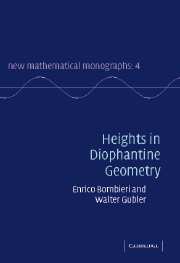Book contents
- Frontmatter
- Contents
- Preface
- Terminology
- 1 Heights
- 2 Weil heights
- 3 Linear tori
- 4 Small points
- 5 The unit equation
- 6 Roth's theorem
- 7 The subspace theorem
- 8 Abelian varieties
- 9 Néron–Tate heights
- 10 The Mordell–Weil theorem
- 11 Faltings's theorem
- 12 The abc-conjecture
- 13 Nevanlinna theory
- 14 The Vojta conjectures
- Appendix A Algebraic geometry
- Appendix B Ramification
- Appendix C Geometry of numbers
- References
- Glossary of notation
- Index
14 - The Vojta conjectures
Published online by Cambridge University Press: 14 August 2009
- Frontmatter
- Contents
- Preface
- Terminology
- 1 Heights
- 2 Weil heights
- 3 Linear tori
- 4 Small points
- 5 The unit equation
- 6 Roth's theorem
- 7 The subspace theorem
- 8 Abelian varieties
- 9 Néron–Tate heights
- 10 The Mordell–Weil theorem
- 11 Faltings's theorem
- 12 The abc-conjecture
- 13 Nevanlinna theory
- 14 The Vojta conjectures
- Appendix A Algebraic geometry
- Appendix B Ramification
- Appendix C Geometry of numbers
- References
- Glossary of notation
- Index
Summary
Introduction
Ch. Osgood [231], [232], was the first to observe, in his researches on diophantine approximation in differential fields, that the corresponding Roth's theorem in that setting could be viewed as analogous to Nevanlinna's second main theorem, with the exponent 2 in Roth's theorem and the coefficient 2 in 2T(r, f) having the same significance. To P. Vojta, in his landmark Ph.D. thesis, goes the credit of finding a solid connexion between classical diophantine geometry over number fields and Nevanlinna theory, thereby leading to far-reaching conjectures, which unified and motivated much further research, see [306], [307].
This final chapter is dedicated to the Vojta conjectures. They may be considered as an arithmetic counterpart of the Nevanlinna theory discussed in Chapter 13 and of which the abc-conjecture, which was the subject of a detailed analysis in Chapter 12, turns out to be an important special case.
The first two sections of this chapter develop Vojta's dictionary establishing a parallel between diophantine approximation and Nevanlinna theory, leading to his conjectures over number fields in Section 14.3. Schmidt's subspace theorem and the theorems of Roth, Siegel, and Faltings now appear as special cases of Vojta's conjectures without the ramification term. This lends support to the validity of Vojta's conjectures and also shows that the crux of the matter in attacking the general case consists precisely in controlling the ramification.
- Type
- Chapter
- Information
- Heights in Diophantine Geometry , pp. 479 - 513Publisher: Cambridge University PressPrint publication year: 2006



